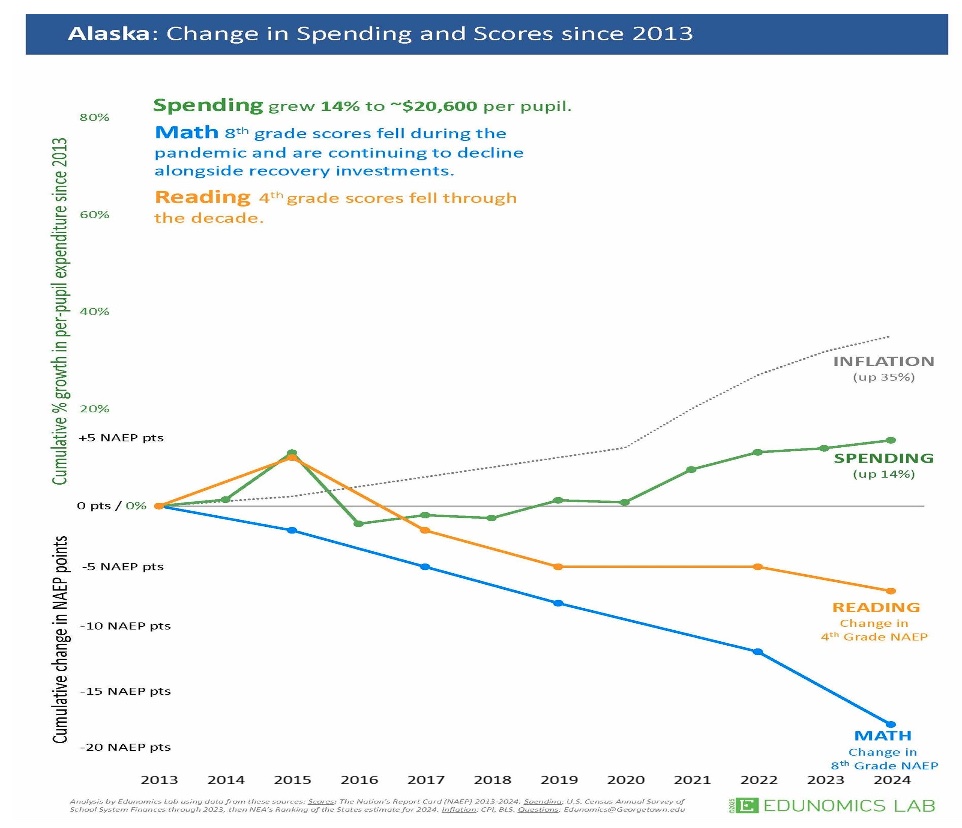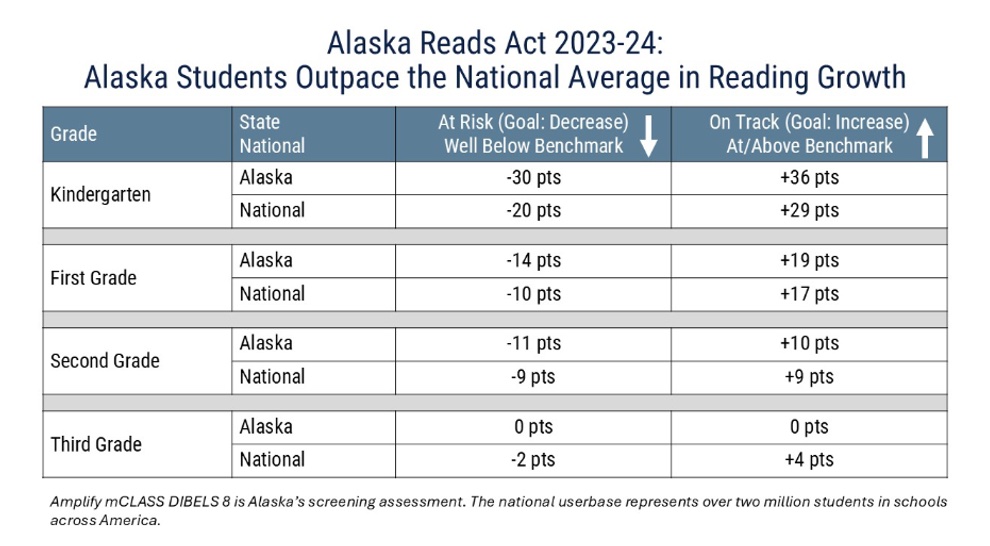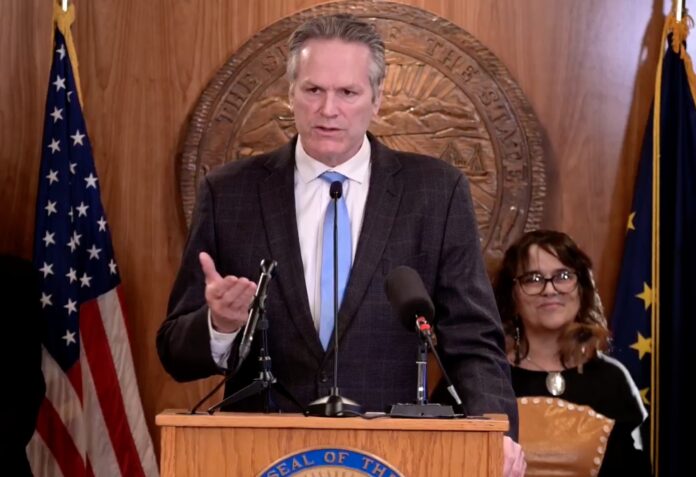By DAVID BOYLE
This week, Gov. Mike Dunleavy provided legislation, HB76 and SB82, to improve Alaska’s education system with accountability for results. He believes that good policy should be implemented before money is thrown at perceived problems.
So, what are the returns on our investment in K-12 education?
Here is a graph that shows the relationship between inflation, Alaska funding, and NAEP 4th grade reading and math scores since 2013:

There appears to be an inverse relationship between spending and student achievement. We can do better, and we need to do better for our kids.
Let’s look at this omnibus K12 education bill. Note the accountability requirements.
The legislation increases education opportunities for parents with open enrollment and increased charter school growth.
Here are the major fiscal policy changes, some of which are changes to the K12 funding formula, making them future funding as well.
Changes to the Correspondence (home school) program:
- Increase funding for correspondence (home school) students from 90% to 100% of the student count (increase of $43M). This ensures that home school students are given full equity.
- For those correspondence students identified as “special needs” and those who enroll in CTE (vocational education), they will also receive that funding. This provides equity for home school students and places them on an equal basis with their brick & mortar students.
- Increases the CTE factor from 1.015 to 1.04 in the K12 funding formula (increase of $31M). This requires the districts to provide plans and reports to the Department, thereby ensuring accountability for the funding.
Changes to the funding of transportation. Because of the increase in the cost of providing student transportation, the state will increase funding by 20% at a cost of $14.5 million. Much of the increased cost is due to energy and increased bus driver wages resulting from the Covid “pandemic.”
The governor proposes to increase funding for nine residential schools by $4 million.
School bond debt reimbursement program is extended to 2030.
Gov. Dunleavy also expands the Alaska Reads Act from K-3 to K-6 and increases funding to $21.9 million. The Act has already shown promising improvement in the K-3 students as shown in this chart:

Many in the education industry have complained that the current funding is not adequate to teach our kids how to read. That begs the question, what are the kids being taught if not reading?
Dunleavy’s bill also increases educational opportunities for all Alaska children by providing open enrollment regardless of zip code. This empowers parents by allowing them to enroll their child in any school within the state-charter, neighborhood public, or correspondence school. The only limitation is the school’s capacity.
So, an Anchorage parent could enroll their child in a MatSu neighborhood school, charter school, or correspondence school. The only hitch is that the parent would have to provide transportation. But districts are also required to establish a student transportation plan as part of this policy.
To provide transparency on school capacities, districts are required to publish on their websites student enrollment data to include school capacity, vacancies for each grade, the number of applications, acceptances, denials, and the reasons for denial.
Better yet, school districts are required to accept students throughout the year as capacity allows. This is extremely important to military families, as not all relocations occur during the summer
Dunleavy wants to expand public charter schools so parents on the waiting lists can get their child to those schools. Unfortunately, the school districts have a stranglehold on the authorizing (startup) of charter schools.
Many of the best schools are our public charter schools but we don’t have enough to support the demand.
The governor wants to fix that problem and help more parents get to the best public schools in the state. Who can oppose that?
The Governor’s legislation proposes to allow the State Board of Education to authorize charter schools anywhere in the state. Additionally, it would allow the University, local municipalities, and any state agency to authorize charter schools.
Surely, school districts will oppose this part of the bill because they do not want to lose their monopolies over even the charter schools. The local districts would be required to operate these charter schools.
Senate President Gary Stevens of Kodiak agrees with the education monopoly, “As I said earlier this week, removing an elected school board’s local control and giving it to an unelected state board to establish charter schools is a no-go.”
The best local control are the parents, not a so-called “elected school board” that bows to the wishes of the teachers’ unions. The finest example is the president of the Anchorage School Board, who was the former president of the Anchorage teachers’ union.
Finally, to improve teacher retention and recruiting, Dunleavy has proposed a teacher bonus program that would provide payments of between $5,000 and $15,000 per year to teachers, depending on the remoteness of the district. These bonuses would be restricted to full-time teachers occupying a position requiring teaching on a regular basis. It is targeted at classroom teachers.
Alaska must do something different to improve the current K-12 system. We are not getting a return on our significant investment of resources.
The battle lines are drawn. We have the “status-quoers” who want to keep throwing more and more money at a system that is failing many children.
Senate President Stevens said that tying educational outcomes to funding needs will not turn this crisis around, “but only exacerbate it.”
And then we have the “reformers” who want to change the system by providing more educational opportunities for all Alaska children.
“We must recognize parental rights so parents may choose the best education path for their child. Focusing on the successful education of all students by meeting their unique needs is the number one priority,” said Sen. Mike Cronk of Tok/Interior.
It seems that the “status quoers” are focused on the institution while “reformers” are focused on parents and students.
Just like an older vehicle, one must make a decision: Should I keep throwing money at the junker and hope it runs for another nine months? Or should I invest my hard-earned money in a new vehicle that will last for many years, thus a greater return on my investment?
Read the bills here:
David Boyle is the education writer at Must Read Alaska.

Absolutely, throwing more money at the problem hasn’t done anything positive. The results have proven that to be a fact. I don’t expect common sense to win in Juneau. The system in Juneau is exactly like the current school system. Neither work for the good of the people or the state. I hope they prove me wrong.
Just burn the whole mess down.
Glad when Dunleavy is gone from the Governor’s job. So, Alaska start looking for great candidates for that job. Now is the time to begin!!
You want to get everyone’s attention “QUICKLY” (???) … Just divert the PDF annual distributions, for the next 10-years, to the SOA – Department of Education. You’ll most likely see more engaged voters!
Dunleavy just said the quiet part outloud. Bad policies need to be flushed like a post-Taco Bell binge party BM. There’s a whole raft of activities and policies that I’ve seen in the Anchorage School District in the past 40 years that were implemented just as our test scores started falling off. Top of the list is the mishmash of gender and DEI hokum. Top of the list; eliminating the push by school nurses and others to convince moody, hormonal, depressed kids that they are trapped in the body of the wrong sex. Parents are complicit in this, too. I took my kids out of school at great sacrifice and schooled them at home. My children have done this too after the ASD started their unscientific actions about COVID and transgenderism. If we had only stood together, spoken up earlier and fought this insanity instead of chatting with other parents and asking, “what is going on?” Perhaps we would not have found ourselves in this position: kids and young adults who can’t read, write, compute, think critically or know which bathroom to use.
Just a guess, bringing up a red herring emphasizing some exaggerated issue of how weird folks can get about disregard for individual differences among kids, fails to address effective strategies in Alaskan public education goals of reading, writing, rhetoric mathematics, and elements of a well-rounded base of knowlege.
Knowledge as foundation for making sound decisions for present and future generations.
Red herring? You sound like an ASD school nurse.
Who wouldn’t want to support charter schools, you ask? ASD School Board, that’s who. They closed the oldest, largest and academically best chart school in the district and stole all of the designated funds that were set aside for students. Around $2.5Mil of it. Carl Jacobs flat out lied about keeping those funds intact and was publicly corrected in a board meeting that exposed his blatant ignorance and deceitfulness. The other people responsible for that theft? Margo Bellamy, and Kelly Lessens, assisted by the corrupt and morally bankrupt narcissist Jessica Parker and profanely belligerent crybaby Shad Schoppert. If you missed those fiery meetings, it is the stuff good really TV is made of. Maybe someday someone will create a documentary about their treachery and maliciousness.
All that aside, I want to know: where is the part about restricting administrative bloat and the senseless overhead of uneeded deputy superintendents, principals, assistant principals, etc etc etc? Used to be a very small single digit percentage on the balance sheet, but administrative costs are rapidly approaching 50% of total staff costs for ASD. That’s ridiculous.
It takes a big Oosik to believe increasing class sizes as a prerequisite to funding will improve test scores
Worth the read in today’s WSJ: Catholic Schools and Jewish Rye
We need to prioritize K-12 students over union members and leadership.
The legislature would rather listen to the vested interests – teachers’ unions and liberal school boards than someone who was an educator like Dunleavy. His experience and observations inform him what is needed. Instead, the legislature has wasted 6 years of his two terms kow-towing to the vested interests instead of parents and the governor. And Senate President Stevens by his own comments is part of the problem. A real shame!
Most parents I know want to increase per-pupil spending to keep programs, sports, librarians, and school nurses, and not increase class sizes. The parents I know work in the oil and gas industry, professional services, as engineers, construction workers, etc. Dunleavy is “kow-towing” to home-school and charter school vested interests. At the end of the day, all of us Alaskans are in this together. Your homeschooled kid may be my caretaker, my doctor, my legislator, etc., someday, so I hope he or she is well-educated. My public-school-educated children may do the same for you or your friends/family someday. Reform, innovation, accountability, improved test scores, etc., are all noble goals, and are shared by many in the middle and middle left. But the likelihood of achieving those goals while starving the education system of funding is low.
One of my friends home-schooled all five of her children. They received a superior education, which was monitored by the educational authorities. All five went on to earn advanced degrees in universities and become leaders in their communities. All were also achievement leaders in their universities. I am less worried about home-schooling and charter schools than public schools, which I have always supported, due to the lack of true innovation in teaching methods. We need to get back to the kind of education that inspired kids to learn more on their own. That should be the real target – creating a life-long learner.
I agree. Lifelong learning and innovation in teaching are noble goals. I don’t think this is an “either/or” issue (and I’m not accusing you of making it one). But to the extent advocates of homeschooling, private schools, and public schools are in tension or opposed on policy, it is important to remember that the kids from each of these modes of education will become our future members of society, and we want them all to be educated and productive. Starving public schools of funding, because you are opposed to curriculum, teaching methods, or teacher unions, is risky, and is the wrong tool to effect change. It seems we are just shooting ourselves in the foot.
The graph shows a reduction in spending in “real” dollars. If inflation is up 35% over the time period and spending is up 14%, then that means a reduction in spending. So the graph does not show an inverse correlation between an increase in spending and test scores. It shows a positive correlation between a reduction in spending and reduced test scores. Maybe Mr. Boyle needs to retake some high school math.